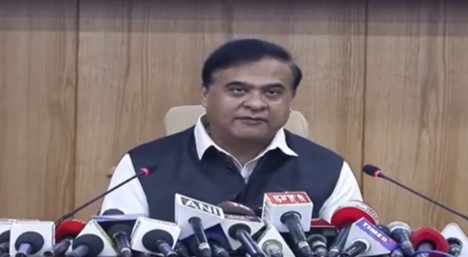Assam has been making impressive strides in the SDG India Index 2023, swiftly climbing the ladder of development achievements alongside a select few States. Under the dynamic leadership of Chief Minister Himanta Biswa Sarma, Assam’s commitment to sustainable growth has been unwavering.
“In 2018, we were at 57 points in the SDG index,” remarked CM Himanta during a recent address, reflecting on the State’s progress. “Today, we have moved up to 71 points, steadily bridging the gap with the national average. Our focus has not been just on numbers but on tangible improvements in areas like environmental sustainability, education, and poverty reduction.”
The NITI Aayog’s latest report, released recently, singled out Assam among the States that have transitioned from aspirants to front-runners in sustainable development. “Between 2018 and 2024, Assam and several other States have accelerated their journey from red to green categories,” CM Himanta highlighted with pride. “This signifies a significant leap forward in our efforts to align with national development goals.”
Highlighting the achievements of other States, the CM shed light on Assam’s remarkable journey in reducing multidimensional poverty and enhancing gender justice. “Our aim is not just to meet but to exceed the national average in key areas like education, hunger reduction, and gender equality within the next two years,” he affirmed.
As Assam continues its upward trajectory in the SDG index, Dr Himanta reiterated the State’s commitment to sustainable and inclusive development. “These milestones are not mere statistics but symbols of our dedication to building a prosperous, equitable, and environmentally sustainable future for all Assamese,” he concluded, underlining the State’s resolve to lead by example in Bharat’s development landscape.
Orunodoi stands out as a pivotal force in significantly reducing poverty rates across Assam, earning national recognition for its impact. The poverty headcount has seen a remarkable drop from 36 per cent to 19 per cent.
While initiatives like MGNREGA, Deendayal Yojana Rural Livelihood Mission, and Ayushman Bharat also play crucial roles, Orunodoi emerges as the standout program in effectively combating multidimensional poverty. Providing Rs 1,250 monthly to 27 lakh families, along with access to free rice and opportunities in MGNREGA, Orunodoi has become a cornerstone in alleviating economic hardship.
Today’s NITI Aayog report reveals a significant decline in poverty rates in Assam, plummeting from 36 per cent to 19 per cent. Despite media and Opposition party’s scepticism about beneficiaries, our steadfast efforts have proven effective in combating poverty. Our latest report underscores a noteworthy achievement: reducing multidimensional poverty from 36 per cent to 19 per cent.
The Assam Government’s dedicated efforts to empower girls have yielded significant results in addressing gender inequality.
Initially criticised for focusing only on providing scooters to girls, the Assam Government’s approach shifted in 2021 towards achieving comprehensive gender justice. This includes combating child marriage and ensuring education for all our daughters.
Today, Assam achieves a remarkable score of 71. Beyond reducing multidimensional poverty, the State also shines in gender equality, particularly due to strict enforcement against child marriages under the age of 18. While some question the necessity of stringent measures, the outcomes are evident. Initiatives like educating girls, distributing scooters and bicycles, and implementing the Nijut Moina scheme have contributed significantly to these achievements, he stated further.
Assam has made significant strides in several areas, notably in improving access to clean water and sanitation through initiatives like the Jal Jeevan Mission (JJM). The government’s efforts in promoting affordable and clean energy have also been noteworthy, transitioning from thermal sources to hydel schemes, such as solar and hydroelectric projects.
Under Goal 8 of sustainable development, Assam has excelled in encouraging decent work and economic growth, maintaining a commendable growth rate of 16 per cent over the past three years. The government’s initiatives in sectors like semiconductors have garnered recognition, while strides in building sustainable cities, despite criticism of projects like Guwahati’s flyovers locally, have been acknowledged nationally. As the lone major city in the State, Guwahati is making substantial progress towards sustainability, outperforming many other metropolitan areas.
For instance, while floodwaters linger for days in cities like Delhi (5 days) and Mumbai (6 days), Guwahati manages floodwaters within a day, showcasing our proactive measures. Assam’s biodiversity and efforts in land management have been commendable, although higher education ratio at 16.5 per cent falls slightly short of Bharat’s 18 per cent. However, with ongoing efforts and upcoming data projections suggesting an increase to 19 per cent, the CM anticipated significant improvement in the 2024 survey.
Terming this achievement as “a historic milestone for Assam”, the CM stated it reflected the government’s commitment to sustainable development goals adopted in 2016 and first published in 2018.
Across Bharat, the starting point was 57 on the SDG Index. Nationally, Bharat progressed to 72, reflecting a significant advancement to 71. This snapshot illustrates the nation’s trajectory under the leadership of Prime Minister Narendra Modi. Now, let me delve into Assam’s SDG goals, mentioned Dr Himanta.
Assam embraced Sustainable Development Goals ahead of other States, setting the tone in 2016 with a commitment to achieving these benchmarks. Initially, in 2018, the Central Government’s first evaluation painted Assam in red, symbolising an aspirant status with unrealised potential.
By 2019, Assam transitioned to yellow, marking its shift into the performer category from aspirant. In the latest SDG Index, Assam proudly wears the green mantle of a frontrunner state, signalling a remarkable journey from aspiration to leadership.

















